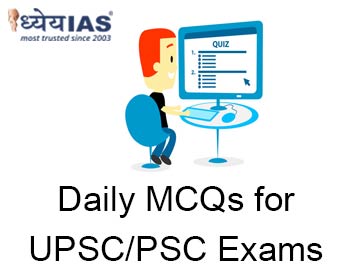Home > Daily-mcqs
Daily-mcqs 25 Jun 2025

Q1:
Which of the following statements is correct in the context of 'Navya Yojana'?
A: This scheme has been launched only to assist graduate girls in higher education.
B: This scheme focuses only on traditional handicraft training.
C: This scheme has been launched to train adolescent girls aged 16–18 years in non-traditional skills under the Pradhan Mantri Kaushal Vikas Yojana.
D: This scheme has been launched only for women in urban areas.
Answer: C
Explanation:
The 'Navya' scheme was launched on 24 June 2025 as a pilot project from Sonbhadra district of Uttar Pradesh. The scheme provides skill training to 10th pass adolescent girls aged 16–18 years in non-traditional areas like drone assembling, graphic designing, smartphone repairing. The aim of the scheme is to make them economically self-reliant.
Q2:
Which of the following statements is correct regarding the Global Peace Index (GPI) 2025?
A: India's ranking in GPI 2025 is 126th, which shows a decline compared to 2023.
B: Global peace level has declined by 1.36 percent in the year 2025.
C: According to the report, South Asia has recorded the highest peace improvement among all regions.
D: India's ranking in GPI 2025 is 115th and peace level has improved by 0.58%.
Answer: D
Explanation:
Option A: False — India's ranking in GPI 2025 is 115th, while in 2023 India's rank was 126th. This means that India's position has improved, not declined.
Option B: Incorrect — The report says that global peacefulness has declined by 0.36%, not 1.36%. Hence, it is factually incorrect.
Option C: Incorrect — South Asia has seen the biggest decline in peace, especially in Bangladesh and Pakistan. It is the second least peaceful region in the world, according to the report. Hence, it is also incorrect.
Option D: Correct — India has been ranked 115th in GPI 2025 and has improved by 0.58%. This improvement indicates progress in India’s internal security, political stability, and border management.
So, the correct answer is D.
Q3:
Consider the following statements based on WMO’s 2024 Report: 1. Asia’s warming rate since 1991 is nearly twice the global average. 2. The average sea surface temperature in Asian waters is rising slower than land temperatures. 3. In 2024, marine heatwaves in Asia affected more than 10% of the world’s ocean area. How many of the above statements are correct?
A: Only 1
B: Only 2
C: All three
D: None
Answer: B
Explanation:
Statements 1 and 3 are correct: Asia is warming almost twice as fast as the global average; marine heatwaves in 2024 impacted 15 million sq. km (approx. 10% of global ocean area). However, statement 2 is incorrect—land temperatures are rising faster than sea surface temperatures.
Q4:
Consider the following statements about WHO’s MPOWER framework: 1. It has six evidence-based tobacco control measures. 2. It was launched in 2008. 3. The ‘O’ stands for ‘Offer help to quit tobacco use’. How many of the above statements are correct?
A: Only 1
B: Only 2
C: All three
D: None
Answer: C
Explanation:
All three statements are correct. The MPOWER package was introduced in 2008 by WHO to help implement the Framework Convention on Tobacco Control (FCTC). It consists of six measures, and ‘O’ refers to “Offer help to quit tobacco use.” This question checks both understanding and memory of technical frameworks.
Q5:
Consider the following statements: 1. SDG Target 8.7 aims to eradicate all forms of child labour by 2025. 2. India has ratified ILO Convention No. 182 on the worst forms of child labour. 3. The Child Labour (Prohibition and Regulation) Act, 1986 clearly defines ‘worst forms of child labour’. Which of the above statements are correct?
A: 1 and 2 only
B: 1 and 3 only
C: 2 and 3 only
D: All of the above
Answer: A
Explanation:
SDG Target 8.7 indeed sets a global goal to end child labour in all its forms by 2025. India ratified ILO Convention No. 182 in 2017, affirming its commitment to eliminate the worst forms. However, India’s domestic law — the Child Labour (Prohibition and Regulation) Act — does not specifically use the ILO terminology “worst forms”. Instead, it focuses on hazardous occupations and processes, which only partially overlap. Hence, Statement 3 is incorrect.